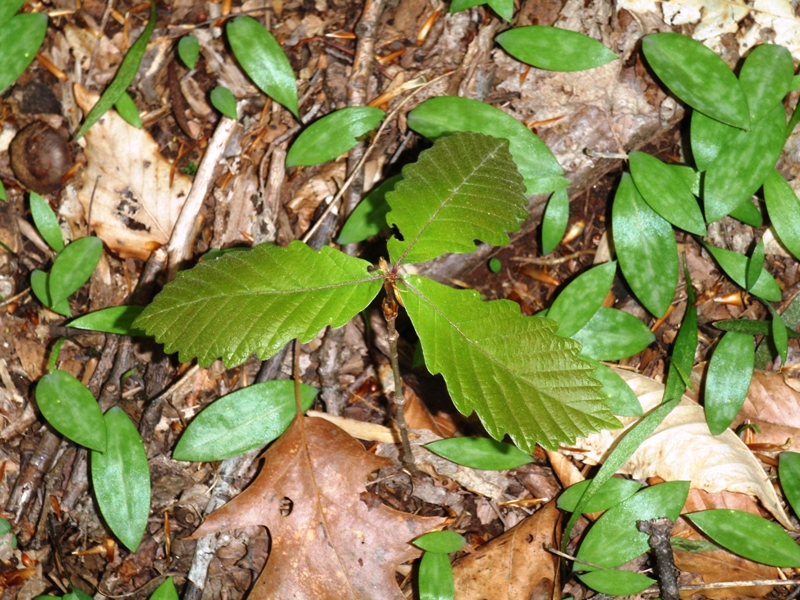|

NPS Photo.
Contact: Kate Jensen, (610) 783-1035 VALLEY FORGE, PA - The forest at Valley Forge National Historical Park is continuing to recover from decades of over-browsing by white-tailed deer. Following five years of implementation of the park's White-tailed Deer Management Plan/Environmental Impact Statement, monitoring by National Park Service staff has documented native seedlings that had not been seen just a few years ago, including maple, red bud, maple-leaf viburnum, dogwood, oak, tulip-poplar, black gum, hickory, cherry, hackberry, ash, and sassafras. The mean number of woody seedlings within 3-square meter test plots increased from two in 2010 to 20 in 2014. Preliminary data indicate an 850% increase in the number of seedlings in the first five years of the implementation of the plan. Kate Jensen, the park's Ecologist, noted, "Park staff and visitors continue to report native trees, shrubs and wildflowers parkwide.It's exciting to see the forest recover." These sightings indicate that the deer management plan is continuing to achieve its objective of allowing the native forest to grow and mature in order to provide habitat for a range of native wildlife species. The increasing deer population over the last two decades and the pressure of over-browsing had eliminated regeneration. No seedlings outside fenced areas had been left uneaten. The absence of vegetation had led to elimination of habitat, soil erosion, and the spread of exotic invasive species. This past year saw a 480% increase in the number of woody stems in the 26-50cm height class, indicating two or more years of survival. In March, the park completed the fifth year of plan implementation. Park staff worked with the United States Department of Agriculture, Animal and Plant Health Inspection Service, Wildlife Services on fourteen nights between November 2014 and March 2015 to remove 195 deer from the park through sharpshooting. A total of 5,023 pounds (over two and one half tons) of meat resulting from this action were donated to the Central Pennsylvania Food Bank and provided to food pantries, soup kitchens, and other organizations across 21 counties in Pennsylvania. The deer management action included extensive measures to ensure a safe, humane, and successful operation, such as using highly qualified and experienced marksmen familiar with the park's geography and with conducting reduction activities in a suburban environment, conducting population reduction actions only when the park is closed, observing safety zones, and using special, non-lead ammunition that is safe for use in the environment. The NPS closely coordinated all activities with township and state law enforcement officials, and with the Pennsylvania Game Commission. The estimated deer density in the park will be 35 deer per square mile (186 deer) after fawns are born this spring. This represents a significant reduction from the estimated 241 deer per square mile (1,277 deer) present in 2009 and the upper limit of the plan's initial target level of 31-35 deer per square mile. Additional forest monitoiring will determine if this density will achieve the forest regeneration goal of 8,079 tree seedlings per acre. Lethal removal activies will continue to keep the population within this initial target density range until and unless forest monitoring indicates the range should be adjusted. Once an acceptable reproductive control agent becomes available, the park will use a reproductive control to maintain the target deer density level. The number of deer removed in future years will be based on the results of annual spring deer population monitoring, updated calculations of deer reproductive rates in the park, and regular forest health monitoring.
About Valley Forge National Historical Park. Valley Forge was the site of the 1777-78 winter encampment of George Washington's Continental Army. The park commemorates the sacrifices and perseverance of the Revolutionary War generation and honors the ability of citizens to pull together and overcome adversity during extraordinary times. For more information about the park, please visit our website atwww.nps.gov/vafoor call 610-783-1099. Follow Valley Forge on social media: Facebook.com/ValleyForgeNHP, Twitter @ValleyForgeNHP, and Instagram @ValleyForgePark and share your photos and experiences. |
Last updated: May 11, 2015
